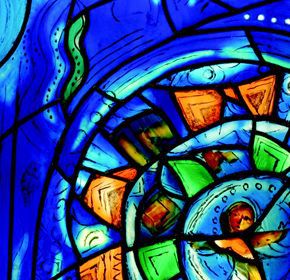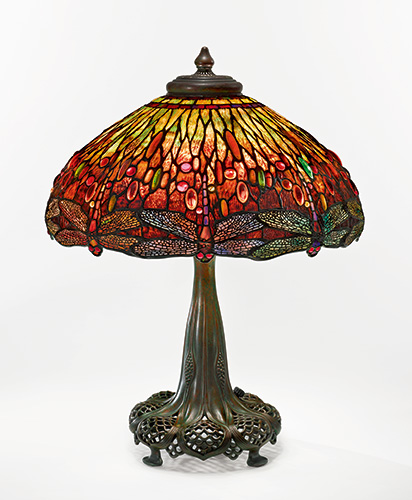|
Glass Art By Cheryl M. Keyser
Glass is an odd medium, made of the most basic of elements - rough grains of sand melted into a liquid form and left to harden. Mixed with different metallic oxides, it attains those characteristic luminous colors or staining. From its humble origins, speculated on by scholars as achieved by sand accidentally falling into fire, it has gained the highest esteem and proved to be one of the most long-lasting arts. Although no one knows who discovered how to convert sand into glass, most researchers trace its origins to the early Egyptians where colored glass beads dating from 2,700 B.C. have been found. By the first century A.D., the Romans were using stained glass windows. The windows we are familiar with today date from the late 11th century in Germany during the Gothic period in art. Starting with this period, some of the grandest cathedrals in Europe featured stained glass windows, which became de riguer in most religious construction. Roughly, the same art periods used in painting are reflected in stained glass, such as the Romanesque style in the Cathedral in Augsberg, Germany, the Gothic style in Notre Dame in Paris, and the Renaissance in the Saint Etienne Church in France. During this period, a level of secularism entered the art with the presence of themes, such as local historic images.
It was not until the middle of the 19th century that the art of stained glass underwent a revival due to such artists as John LaFarge (1835-1910), Louis Comfort Tiffany (1848-1933), Frank Lloyd Wright (1867-1959), and French artist Marc Chagall (1887-1985). And with that came a change in what was being presented in stained glass. Although religious themes still predominated, artists were delving into secular themes, ranging from depictions of nature, to themes on the arts, as the Chagall panels at the Art Institute in Chicago. Tiffany became the most notable as he went beyond windows into such home decor items as lamps for which he was famous. Indeed, his renown still brings high prices on the auction market. Certainly, no one of his generation could imagine the prices that a Tiffany lamp would obtain today. In 2015, for instance, a dragonfly lamp, originally in the Andrew Carnegie collection and with impeccable provenance, was listed at an estimated price of $250,000 to $350,000. When the hammer descended, the lamp sold for over $2 million. His windows still draw attention, although they may not be well known to the general public. Scattered throughout Franklin County in south central Pennsylvania, a mainly agricultural area, various sites display signed Tiffany windows. It seems an unlikely area to find work as sophisticated, and until lately they have not received much interest. But that is also changing, as bus tours take groups to visit the various examples of the art. Two are in Presbyterian churches in downtown Chambersburg (the county seat), nearby Wilson College, Mercersburg Academy, and two other churches. One window alone measures 25 feet in height. Today stained glass is attracting a large group of both those who make it and those who appreciate it. The Stained Glass Association of America (SGAA), which represents most of the major stained glass studios in the United States, has been around since 1903, underscoring the strength of demand in this area. In addition to its member activities, it also offers classes and scholarships for aspiring artists. One of its Board members is David Judson, a fifth generation stained glass artist. He can trace the origins of the California-based Judson Studios to his great-great grandfather. This first Judson, William Lees, was a plein air painter born in England, moved to Canada, and then the United States. He trained his sons in stained glass techniques and it has come down through the generations (and possibly a sixth). "About 80% of our commissions are for religious art," said David Judson. But the Studio also does commercial and residential work, including public murals and private homes, one of which features a stunning stained glass skylight. "Artists are looking for other venues to express themselves," said Judson, "and this field not only demands a high level of craftsmanship, but also is a permanent medium which has existed for over 1,000 years." Stained glass is a collectible in the making, showing a renewed appreciation for handcrafted pieces in this digital age. Although few can afford millions for a Tiffany lamp, now is the time to explore the market and seek out interesting pieces at comfortable prices. Do some homework (SGAA offers extensive information) and visit some of the studios. That is the best way to sort the wheat from the chaff, so to speak, and enter an older world of art that has been shaped by new world artists. Illustrations from top to bottom: |
 For
centuries, stained glass has been the glory of churches, almost as if it
is a special art crated solely for religious reasons. In truth, there is
some validity to this. In the early churches, stained glass windows,
depicting images from the Bible or lives of the saints, were used to
educate the faithful about their religion. Until the invention of
printing, this was the only way to reach the masses of Christians
no matter their denomination. Thus, the windows were a source of
instruction as well as beauty.
For
centuries, stained glass has been the glory of churches, almost as if it
is a special art crated solely for religious reasons. In truth, there is
some validity to this. In the early churches, stained glass windows,
depicting images from the Bible or lives of the saints, were used to
educate the faithful about their religion. Until the invention of
printing, this was the only way to reach the masses of Christians
no matter their denomination. Thus, the windows were a source of
instruction as well as beauty. By
the time of the Renaissance, however, painting had become the most
prominent art form. Until about the 19th century stained glass fell into
disfavor for various reasons. For instance, about the17th century, the
English Parliament ordered religious images removed from churches as
friction - indeed clashes between religions - were at their height,
evidenced by the exodus from Great Britain of religious groups who did
not accept "graven images" in their religious establishments.
By
the time of the Renaissance, however, painting had become the most
prominent art form. Until about the 19th century stained glass fell into
disfavor for various reasons. For instance, about the17th century, the
English Parliament ordered religious images removed from churches as
friction - indeed clashes between religions - were at their height,
evidenced by the exodus from Great Britain of religious groups who did
not accept "graven images" in their religious establishments.